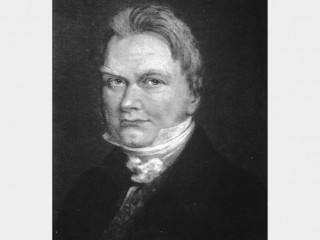
Berzelius Jöns Jacob biography
Date of birth : 1779-08-20
Date of death : 1848-08-07
Birthplace : Väversunda, Östergötland, Sweden
Nationality : Swiss
Category : Science and Technology
Last modified : 2010-05-30
Credited as : Chemist, organic chemistry, Berzelius Medal
1 votes so far
Jons Jakob Berzelius was one of the founders of modern chemistry. He discovered Ce, Se, Si, and Th; first used the term “organic chemistry”; first to electrolyze salts; invented series of electronegativities; suggested modern symbols for elements and invented modern chemical formulas; proposed words: isomerism, allotropy, catalysis, protein, polymer, halogen, and electronegative; proved law of definite proportions; generated first accurate list of atomic weights; invented the mercury cathode; discovered ammonium amalgam and pyruvic acid; studied chemistry of silicic acid; extensively investigated fluorides of many elements; analyzed meteorites and concluded they were of extraterrestrial origin.
He was a strict empiricist and insisted that any new theory be consistent with the sum of chemical knowledge.
Jons Jakob Berzelius was born into a well-educated Swedish family, but he experienced a difficult childhood because first his father and then his mother died. As a boy Berzelius developed an interest in chemistry. While in medical school at the University of Uppsala, he read about Volta’s “pile” and immediately constructed one for himself. Except for his fine performance in physics, however, he nearly failed in his medical studies at Uppsala, but he did receive an M.D. degree (1802) and became assistant professor of medicine, botany, and pharmacy at Stockholm.
His thesis for his medical degree was on the effect of electric shock on patients with various diseases. Even though he reported no improvement in his patients, his interest in electrochemical topics continued. A full professor by 1807, he was elected to the Stockholm Royal Academy of Science the following year and became permanent secretary in 1818. Professor of chemistry at the Royal Caroline Medico-Chirurgical Institute in Stockholm (1815-32), he was made a baron by Charles XIV in 1835.
Jons Jakob Berzelius was one of Humphry Davy’s contemporaries and rivals. Like Davy he became an accomplished experimenter in the field of electrochemistry, but Berzelius’s mind was much more systematic than Davy’s: He was given to running programs of hundreds of experiments and then deriving organized generalizations from them. In preparing a chemistry textbook in Swedish for his medical students (Larboki Kemien, vol. 1, 1808), Berzelius began the series of experiments for which he became most famous – those definitively establishing that the elements in inorganic substances are bound together in definite proportions by weight (the law of constant proportions).
His interest in all sorts of compounds led to his discovery of a number of new elements, including cerium, selenium, and thorium. Students working in his laboratory also discovered lithium, vanadium, and several rare earths. Using his experimental results, he determined the atomic weights of nearly all the elements then known. Dealing with so many elements in so many compounds motivated his creation of a simple and logical system of symbols – H, O, C, Ca, Cl, and so forth – which is basically the same as the system we use today, except that the combining proportions of the atoms of elements in a compound were indicated as superscripts instead of our subscripts.
Working in his spare time and with meagre kitchen laboratory facilities and techniques of his own improvisation and development, he studied about 2,000 compounds over a 10-year period. He used oxygen as the basis of reference for the atomic weights of other elements and was guided by the law of multiple proportions, atomic theory, the principles of isomorphism, and Gay-Lussac’s law of combining volumes. His resulting table of combining proportions and atomic weights, published in 1818 and revised in 1826, attained a remarkable degree of accuracy. Berzelius also applied his organizing abilities to mineralogy, where he classified minerals by their chemical composition rather than by their crystalline type, as had previously been done.
The major intellectual synthesis of Berzelius’s career was “dualism” – a line of thinking that could be traced back to the original electrochemical investigations both he and Davy had made. Because compounds were decomposed by an electrical current and released elements were formed at the poles in an electrolytic cell, he assumed that atoms were charged and chemical combination resulted from the mutual neutralization of opposite charges. Dualistic thinking worked quite well, except in the emerging realm of organic chemistry.
Berzelius discovered the elements cerium (1803), selenium (1817), and thorium (1828). He isolated silicon (1823), zirconium (1824), and titanium (1825); classified minerals on a chemical basis; and made detailed studies of the compounds of tellurium, vanadium, molybdenum, tungsten, uranium, and other elements. Sometimes called the father of gravimetric analysis, he introduced the use of the water bath, desiccator, wash bottle, filter paper, rubber tubing, and improved blowpipe technique.
He published more than 250 original papers, mostly in Swedish, in the Transactions of the Stockholm Academy. His progress reports on chemistry and physics and his textbook of chemistry, which went through five editions and was translated into German and French, greatly influenced the development of chemistry in his time.
Berzelius was also a great organizer of men and institutions. As the Permanent Secretary of the Royal Academy of Sciences in Stockholm (1818-1848), he revived what had become a moribund organization. He continued to write textbooks, which were widely translated, and in 1822 he began a series of annual reports on the status of chemistry in Europe, which were also made available in other languages.
Berzelius died on August 7, 1848, Stockholm, Sweden.
Berzelius Medal was established by the Royal Swedish Academy (awarded once every 50 years) to memorize the famous scientist.
Museum of Berzelius: The museum used to be located on the grounds of the Swedish Royal Academy of Science on the north side of Stockholm, Sweden. The museum was closed in January of 2001 and, at this writing, plans were in the works to move the museum to a different site and reopen it in 2004.
















